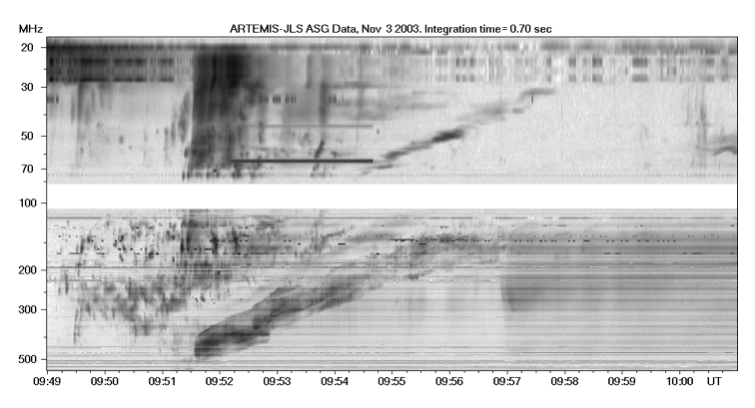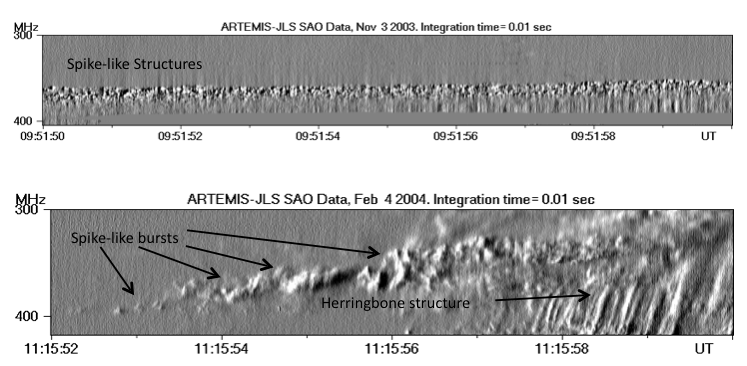Type II solar radio bursts are the result of energetic electrons accelerated by a shock. This kind of burst appears on dynamic spectra as lanes which drift slowly from high to lower frequencies. Often, we observe a fundamental – harmonic structure, which sometimes exhibits a division on each band called band-split.
Fine structures are emissions with short duration and bandwidth embedded within all types of radio bursts and constitute a useful tool for diagnostics of local parameters. Although spikes associated with Type III (Benz et al, 1982, 1996) and Type IV radio bursts have been analyzed (Bouratzis et al., 2016), in Type II radio bursts they have not been examined comprehensively. Most common fine structure reported in Type II radio bursts are herringbone. On the other hand, spike bursts have only been mentioned once in decametric wavelengths (Chernov et al 2007), see also review by Chernov (2016).
Using the high time resolution (10ms) acousto-optic analyzer (SAO) of the Artemis-JLS radio spectrograph (Kontogeorgos et al 2006) we detected spike-like structures within Type II dynamic spectra.

Figure 1 – An example of a Type II radio burst, along with type III and IV bursts, recorded with the sweep frequency receiver (ASG) of the Artemis-JLS spectrograph with 0.1s temporal resolution.
Results
We identified more than a hundred Type II radio bursts using the ASG receiver (Figure 1) and we selected 4 events which were recorded by the Artemis-JLS/SAO receiver in the 450-270 MHz frequency range. The high time resolution of the receiver facilitated the detection of small scale bursts on the dynamic spectra. We identified 642 short and narrowband structures. These spike-like bursts mostly appeared in groups or chains which drifted almost parallel to the Type II front. Isolated bursts were also occasionally detected. Herringbones and pulsations were also observed to co-exist with these structures. (Figure 2)

Figure 2 – Upper Panel: Artemis-JLS/SAO dynamic spectrum of the 3 November 2003 event; 10 sec segment and 110 MHz frequency range. Lower Panel: Artemis-JLS/SAO dynamic spectrum of the 4 February 2004 event; 8 sec segment and 110 MHz frequency range. In both cases the time derivative of the dynamic spectrum is displayed to enhance small time scale structures.
Their average duration (96ms) and relative bandwidth (1.7%) were measured and compared with similar structures observed within Type IV radio bursts. (Table 1)
|
Type II Spike-like Bursts |
Type IV Spikes |
|
Duration (ms) |
|
|
96 |
100 |
|
Relative Bandwidth (%) |
|
|
1.7 |
2.0 |
Table 1 – Comparison between spikes in Type IV radio bursts Bouratzis et al. (2016) with spike-like structured detected in Type II bursts.
Conclusions
Type II spikes constitute a new class of fine structure with properties similar to Type IV spikes. They are most probably manifestations of small sale reconnection events along the front of the shock.
Additional info
This article is based on the recently published paper: S. Armatas, C. Bouratzis , A. Hillaris, C.E. Alissandrakis, P. Preka-Papadema, X. Moussas, E. Mitsakou, P. Tsitsipis, A. Kontogeorgos, 2019, Astronomy & Astrophysics, 624, A76 DOI: 10.1051/0004-6361/201834982
References
Bouratzis, C., Hillaris, A., Alissandrakis, C. E., et al. 2016, A&A, 586, A29
Benz AO, Jaeggi M, Zlobec P. 1982 A&A, 109, 305
Benz AO, Csillaghy A, Aschwanden MJ. 1996 A&A, 309, 291
Chernov, G. 2016, In: Solar Flares: Investigations and Selected Research (Nova Science Publishers Inc.)
Chernov, G. P., Stanislavsky, A. A., Konovalenko, A. A., et al. 2007, Astron. Lett., 33, 192
Kontogeorgos A, Tsitsipis P, Caroubalos C, et al.. 2006 Experimental Astronomy 21, 41
*Full list of authors: S. Armatas, C. Bouratzis , A. Hillaris, C.E. Alissandrakis, P. Preka-Papadema, X. Moussas, E. Mitsakou, P. Tsitsipis and A. Kontogeorgos
